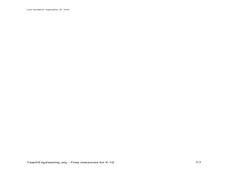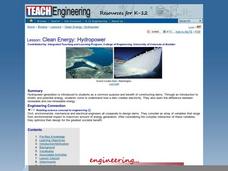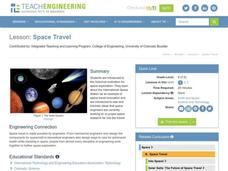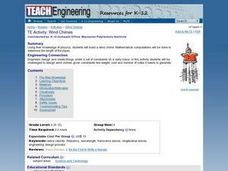Curated OER
Plumbing the Deep-Using Sound Waves to See
Young scholars explore and learn about the concept of echolocation. In this echolocation lesson, students explore how animals and engineers use echolocation (seeing under water) and sound waves to look and hear things under the deep water.
Curated OER
Clean Energy: Hydro-power
Students read about and discuss renewable and non renewable energy and identify how a dam produced energy using hydro-power. In this water energy lesson plan, students look at diagrams and pictures of water energy technology.
Curated OER
Acid (and Base) Rainbows
Learners are introduced to the differences between acids and bases and how to use indicators, such as pH paper and red cabbage juice, to distinguish between them. They make predictions that can be answered through scientific...
Curated OER
Making & Breaking : The Rock Cycle
Students examine the rock cycle and how rocks can change over time. In this geotechnical engineering instructional activity students draw a diagram of the rock cycle.
Curated OER
Breathe In, Breathe Out
Students study the respiratory system, the lungs and air. In this respiratory instructional activity students describe technologies that engineers have found that improve the health of the respiratory system.
Curated OER
Measure Twice, Cut Once
Elementary schoolers learn about metric units and how they are used by engineers. They learn how engineers use the units to measure mass, distance, and volume. Then, they estimate measurements of units, and compare them to actual...
Curated OER
Space Travel
Students study the International Space Station and space exploration. In this space travel instructional activity students describe the different types of engineers that contribute to space travel.
Curated OER
Stressed and Strained
Students explore stress and strength in engineering design. In this engineering lesson, students become familiar with terminology associated with stress and strain on building material. They will have a class discuss about how their beam...
Teach Engineering
Biological Processes: Putting Microbes to Work
Is there such a thing as useful microbes? Get ready to perform experiments on applying microbes for wastewater treatment. The first installment of the three-part unit provides background information to prepare young engineers for two...
Teach Engineering
Basically Acids
Base your lesson plan on acids and bases on an informative resource. The first installment of a five-part module on the science behind Harry Potter has individuals investigate acid/base chemistry with the use of invisible inks. They also...
Teach Engineering
Win that Bid! Selling Your Power Solution
Power up! Class members research a type of power production using a great resource featuring a real-world problem. Groups select a type of power generation and pretend that they represent an engineering firm for their chosen power type....
Curated OER
The Crash Scene
Fifth graders explore geography by participating in a mapping activity. In this engineering lesson plan, 5th graders identify the differences between latitude and longitude and practice locating precise points on a globe or map. Students...
Curated OER
The Global Precipitation Measurement Mission (GPM) Lesson
Introduce your class to one of the ways that technology is benefiting humanity. The Global Precipitation Measurement Mission involves the data collected by nine satellites from different countries with a united focus on studying world...
Curated OER
Using Heat
The 6 slides give a few examples of ways that we use heat and heating systems. There is a diagram of circulation in a stove and forced air system as well as other examples of heat movers. Great for an introduction.
Texas State Energy Conservation Office
Power Systems & Efficiency
Are you looking for a reading resource about the efficiency of power systems? Here is one that introduces the output/input ratio, measurement of energy by joules or calories, and efficiency ratings. For STEM classes that are learning...
Curated OER
Preparation for Engineering Careers
Students explore all the careers that deal with math, science, technology and engineering. They assess the importance of clearly explaing yourself in writing, making public presentations and utilizing technical jargon in dealing with...
Curated OER
Science and Technology
Eighth graders explore the roles of science and technology in today's world. They research a topic based on the uses of science in society. Students discuss medicine, power, transportation, water and sewage treatment and stereos, TVs....
Curated OER
Wind Chimes
Students construct wind chimes using physics. In small groups they design and create wind chimes using a specific weights, number of notes, and keeping the cost under ten dollars.
Curated OER
Disassemble a Click Pen
Students dissamble and analyze the spring system of a click pen. They analyze a cross-section worksheet, dissamble the pens, fill in the missing parts of the cross-section diagram, and write a description of how the pen works.
Curated OER
Online Search Techniques: 6 Keys to Success
Students examine Boolean operators, truncation, exact phrase searching to retrieve information from search engines. They discover how using limits enhances their searches.
Curated OER
Bridges
Students compare and contrast the three primary types of bridges. In this technology lesson plan, students design and build a bridge that spans 25 cm. They test their design and present the results to class.
Curated OER
Graphic Editing
Students use various hardware and software tools to create and edit files which can be used in a presentation. They use a search engine to find and download an image. Students use computer tools to save the image. Once saved, the image...
Curated OER
Tools: Science Stations
Students explore technology by completing engineering activities in class. In this simple tools lesson, students utilize three science stations to perform tasks using a nutcracker, bottle openers, hammers and other tools. Students review...
Curated OER
Technology of War Questions
In this Canadian history worksheet, students read Canadian History, by Ian Hundey and then respond to 7 short answer questions about war technologies.

























